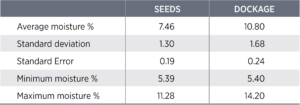Three Short Articles
Application basics for Optimum GLY
Corteva Agriscience’s glyphosate-resistant canola system, Optimum GLY, launched in 2023 and will be available in a few cultivars for 2024.
Crop stage: Glyphosate can be applied to Optimum GLY canola from cotyledon to first flowers. “Optimum GLY expands the window of application past the six-leaf stage, allowing farmers the flexibility to time their herbicide application to maximize weed removal options,” says Mark Kuchuran, product manager with Corteva Agriscience. “This gives producers time to cover large acres or clean up late flushes of weeds without the risk of yield impact from late-season applications.”
Rate: Growers can use any approved glyphosate herbicide on Optimum GLY canola at rates up to two Roundup equivalent litres (RELs) per acre per season. One REL is equivalent to 360 grams of active ingredient per litre. Growers can apply the two RELs in one pass or as two passes, at least 14 days apart, of one REL/acre each. “For optimum weed control, it is recommended to spray the required amount of glyphosate as early as possible,” Kuchuran says.
Real-time variable rate
Precision Planting’s SmartFirmer provides real-time in furrow information that can trigger automatic seed and nutrient rate adjustments on the fly.
SmartFirmer optical sensors operate in the seed furrow, measuring reflectivity of the soil at various wavelengths. These measurements are correlated to soil moisture and organic matter. Being a U.S. Midwest company, Precision Planting provides a corn example: A corn grower could choose to plant 32,000 seeds per acre in soil that has one per cent organic matter and 40,000 seeds per acre in soil with 3.5 per cent organic matter. SmartFirmer feeds real-time organic matter data into the planter computer, and the computer adjusts the seeding rate accordingly. The system can also adjust liquid nitrogen, reducing application rates in soils with higher organic matter where the soil is more likely to provide nitrogen from mineralization.

“The speed of response is due to the extreme speed of the computers inside the SmartFirmer, vDrive and vApply, which are orders of magnitude faster than any human response,” says Dale Koch, product manager at Precision Planting research facility at Tremont, Illinois. (Precision Planting is a division of AGCO.) “It can respond as fast as it takes for a seed to drop from the meter to the ground, which is no more than a few feet at typical planting speed.”
SmartFirmer requires the Precision Planting 20/20 monitor and electronic architecture. SmartFirmer units are about US$800 per row, and the number per seeding unit is up to the farmer. “You need a minimum of three per planter for any control to be done automatically,” Koch says. “Since there is variability by row across the field, the more the better.”
Dockage has higher moisture than seed
Dockage is a storage risk for canola. It can collect along bin edges and, because it usually has higher moisture than seed, can create a hot spot for mould growth. This small hot spot can cause a chain reaction that could eventually spoil a whole bin.
The Canadian Grain Commission used a small subset of samples collected though the Harvest Sample Program this past fall to compare canola seed moisture and dockage moisture. It separated 49 samples into seed and dockage and noted considerable differences. Average seed moisture for the 49 samples was 7.46 per cent, which is perfect for safe long-term storage of canola. The CCC recommends eight per cent. However, average dockage moisture was 10.8 per cent. If that dockage clumps together, as it often does, this could present a storage risk. Keep this in mind when checking bins.Canola with high dockage, especially straight combined canola where you know the dockage could be on the green side, could be at risk – even if the seeds are dry.
“Monitoring your stored canola on a regular basis from the time it enters the bin, to the time it leaves will reduce your risk for dockage due to spoilage,” says Courtney Ross, agronomy specialist and storage lead with the Canola Council of Canada.
Thank you to Veronique Barthet, oilseeds program manager at the Canadian Grain Commission’s Grain Research Laboratory in Winnipeg, for running this survey.
Moisture results for the 49 canola samples





